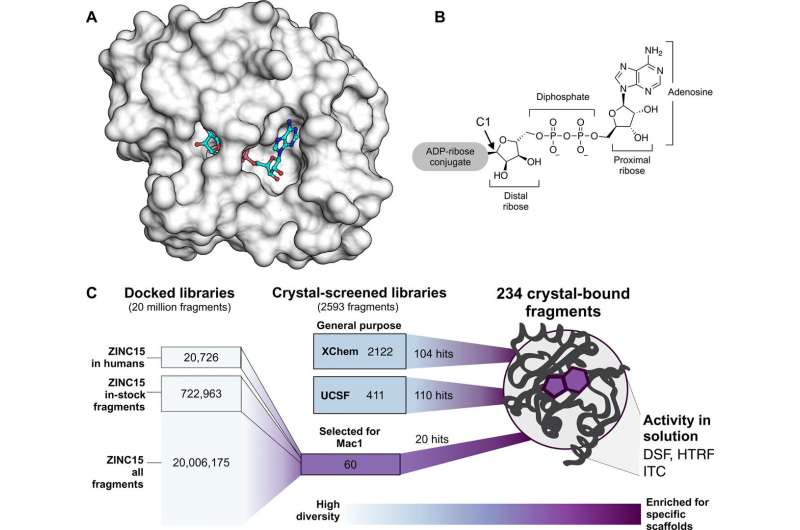Researchers search for clues to COVID-19 treatment with help from synchrotron X-rays

Vaccination, masks and physical distancing help limit the spread of COVID-19—but, researchers say, the disease is still going to infect people, and doctors are still going to need better medicines to treat patients. This may be especially true for cancer patients and other at-risk people who may lack a sufficiently strong immune system to benefit from the vaccine.
Now, two teams working in part at the Department of Energy's SLAC National Accelerator Laboratory have found some clues that could, down the road, lead to new COVID drugs.
The researchers, from John Tainer's lab at MD Anderson Cancer Center and James Fraser's group at the University of California, San Francisco, focused on a molecular structure that is common to all coronaviruses but has proven especially troublesome in the case of the virus that causes COVID-19. The structure contributes both to the virus's ability to replicate and to immune system overreactions that have proven particularly deadly.
The trouble, Fraser said, is that scientists don't know what kinds of molecules would bind to the structure, known as the Nsp3 macrodomain, let alone how to combine such molecules to interfere with its deadly work.
To remedy that problem, Fraser's group screened several thousand molecules at facilities including SLAC's Stanford Synchrotron Radiation Lightsource (SSRL) to see where and how well the molecules bound to crystallized forms of Nsp3. The team combined those results with computer models to understand how the molecules might affect the structure of the macrodomain and whether they might help inhibit its function.
The study concludes with a hypothesis about how to "stitch together" several small molecules to create a drug that might help treat COVID-19, Fraser said. The study was published April 14 in Science Advances.
Tainer's group conducted a similar analysis, this time focused on a class of molecules that have proven useful in treating certain cancers. Those molecules target a protein within cancer cells that is analogous in structure and function to the Nsp3 macrodomain, Tainer said, so the team used SSRL's X-rays to study how those molecules interacted with the macrodomain and whether they might be able to inhibit its function. The study was published in Progress in Biophysics and Molecular Biology.
Both Fraser and Tainer emphasized that they have not yet identified COVID-19 drug candidates, but rather clues that may help researchers looking to design drugs. All the same, Tainer said, now that teams are finding those clues, "there's no insurmountable barrier" and the results from both groups "provide a path forward" to design successful drugs.
Tainer also emphasized the role that facilities like SSRL play in developing new medicines. "The heroes of the story are the synchrotron beamlines," Tainer said. "These facilities are critically enabling technologies for addressing a national need."
More information: Marion Schuller et al. Fragment binding to the Nsp3 macrodomain of SARS-CoV-2 identified through crystallographic screening and computational docking, Science Advances (2021). DOI: 10.1126/sciadv.abf8711
Chris A. Brosey et al. Targeting SARS-CoV-2 Nsp3 macrodomain structure with insights from human poly(ADP-ribose) glycohydrolase (PARG) structures with inhibitors, Progress in Biophysics and Molecular Biology (2021). DOI: 10.1016/j.pbiomolbio.2021.02.002





















